Satorius CP622, CP225D, CP2P-F, CP2P, CP User Manual
...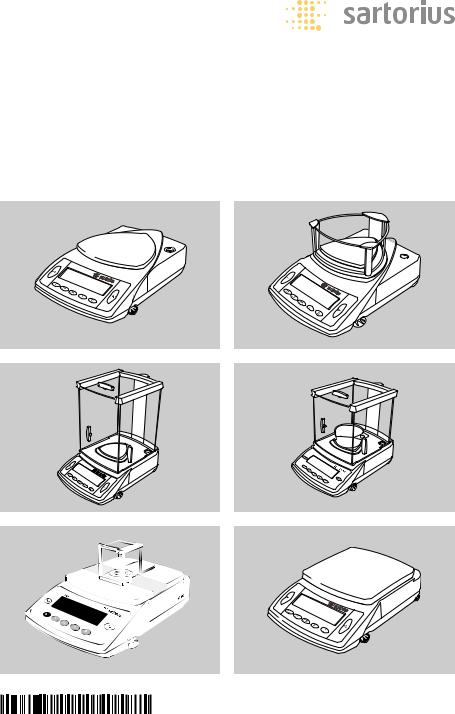
Operating Instructions
Sartorius Competence | CP Series | Sartorius Gemplus
CP, GC and GP Models
Electronic Microand Analytical Precision Balances and Precious Metal Scales
98648-009-91

Contents
2 Contents |
50 |
Generating a Printout |
|
53 |
ISO/GLP-compliant Printout |
3Intended Use
|
Warnings and |
55 |
Data Interface |
|
4 |
59 |
Data Input Format |
||
|
Safety Precautions |
62 |
Pin Assignment Chart |
|
5 |
Getting Started |
63 |
Cabling Diagram |
|
64 |
Error Codes |
|||
15 |
Operation |
|||
65 |
Preparing CP2P.. |
|||
15 |
Overview of Display and |
|||
|
Operating Elements |
|
Models for Transport |
|
16 |
Basic Weighing Function |
66 |
Care and Maintenance |
|
18 |
Below-Balance/Under-Scale |
|||
|
Weighing |
68 |
Instructions for Recycling |
|
20 |
Calibration/Adjustment |
|||
24 |
Configuration |
69 |
Overview |
|
24 |
Printing the Settings |
69 |
Specifications |
|
25 |
Setting the Parameters |
82 |
Accessories (Options) |
|
|
(Menu Codes) |
85 |
Declaration of Conformity |
|
26 |
Parameter Settings (Overview) |
89 |
Plates and Markings |
31Setting IDs, Time, Date and Display Brightness
34Application Programs
35Net-Total Formulation
39Counting
40Reference Weighing
43Weighing in Percent
46Animal Weighing/Averaging
49Toggle between Weight Units
2

Intended Use
The models of the CP, GP and GC Series are weighing instruments of special and high accuracy designed for the measurement of mass, covering a range from 0.001 mg to 34 kg.
CP, GP and GC models meet the highest requirements on the accuracy and reliability of weighing results through the following features:
–Efficient filtering-out of unfavorable ambient conditions, such as vibration, drafts, etc.
–Stable and reproducible weighing results
–Excellent readability under any lighting conditions
–Rugged, durable weighing system
These weighing instruments save work and speed up simple routine applications through these features:
–Extremely fast response times
–Built-in applications (counting, net-total formulation, animal weighing, weighing in percent, etc.)
–Total ease of operation
–ISO/GLP-compliant recording capability for printouts
–Serial RS-232 port for optional connection to a PC
3

Warnings and Safety Precautions
The balance/scale has been constructed in accordance with the European Directives as well as international regulations and standards for operation of electrical equipment, electromagnetic compatibility, and stipulated safety requirements. Improper use or handling, however, can result in damage and/
or injury.
To prevent damage to the equipment, please read these operating instructions carefully before using your balance/scale. Keep these instructions in a safe place. Follow the instructions below to
ensure safe and trouble-free operation of your balance/scale:
!Do not use this balance/scale in a hazardous area/location.
!If you use electrical equipment in installations and under ambient conditions requiring higher safety standards, you must comply with the provisions as specified in the applicable regulations for installation in your country.
!Make sure that the voltage rating printed on the AC adapter is identical to your local line voltage.
!Warning when using pre-wired RS-232 connecting cables: The pin assignments in RS-232 cables purchased from other manufacturers may be incompatible with Sartorius balances/scales. Be sure to check the pin assignment against the chart on page 62 before connecting the cable, and disconnect any lines marked “Internally Connected.”
–The only way to switch the power off completely is to disconnect the AC adapter.
–Connect only Sartorius accessories and options, as these are optimally designed for use with your Sartorius balance/scale.
–Note on Installation:
The operator shall be responsible for any modifications to Sartorius equipment and for any connections of cables or equipment not supplied by Sartorius and must check and, if necessary, correct these modifications and connections. On request, Sartorius
will provide information on the minimum operating specifications (in accordance with the Standards for defined immunity to interference).
IP ratings:
–CP34001S, CP34001P, CP34000, CP16001S and CP12001S meet IP44 requirements
–Additional models with readabilities > 10 mg meet IP53 requirements
–Models with readabilities < 1 mg meet IP32 requirements
–AC adapters meet IP20 requirements
–Protect the AC adapter and the weighing instrument from contact with liquids.
When cleaning your balance/scale, make sure that no liquid enters the balance/scale housing; use only a slightly moistened cloth to clean the balance/scale.
Do not open the balance/scale housing. If the seal is broken, this will result in forfeiture of all claims under the manufacturer’s warranty. If you have any problems with your balance/scale:
$Contact your local Sartorius office, dealer or service center
4

Getting Started
Storage and Shipping Conditions
Do not expose the balance/scale to extreme temperatures, blows, shocks, vibration
or moisture.
Unpacking the Equipment
§After unpacking the balance/scale, check it immediately for any visible damage as a result of rough handling during shipment
$If you see any sign of damage: proceed as directed in the section on
“Safety Inspection" in the chapter entitled “Care and Maintenance."
It is a good idea to save the box and all parts of the packaging until you have successfully installed your balance/scale. Only the original packaging provides the best protection for shipment.
Before packing your balance/scale, unplug all connected cables to prevent damage.
Equipment Supplied
The equipment supplied includes the components listed below:
CP2P, CP2P-F
–Balance with display and control unit
–Kit of standard accessories
–AC adapter
–Dust cover
–Gem tray (GC scales only)
–Filter pan and lid
–Spacer (model CP2P-F only)
The kit of standard accessories contains the following:
–Weighing pan
–Interior draft shield
–Hanger for below-balance weighing
–1 brush
–1 pair of forceps
–1 piece of lint-free cloth
5

Equipment Supplied
The equipment supplied includes the components listed below:
CP Balances with Readability of < 0.1 mg; CP…-DS Scales, GC Scales
–Balance/scale with display and control unit
–Electronics box (model CP225D only)
–Draft shield with base plate
(not available for the CP64-WDS)
–AC adapter
–Weighing pan
–Shield disk (not available for CP…-DS models)
–Dust cover
–Gem tray (GC scales only)
CP Balances with Readability of 1 mg (except for the CP…-DS models)
–Balance with display and control unit
–Draft shield with cover
–AC adapter
–Weighing pan
–Pan support
–Base plate
CP Balances with Readability of 0.01 g/0.1 g, GP Scales
–Balance/scale with display and control unit
–AC adapter
–Weighing pan
–Pan support (model CP622 only)
–Gem tray (GP scales only)
CP34001S, CP34001P, CP16001S, CP12001S, CP34000
–Balance with display and control unit
–AC adapter
–Weighing pan
Installation Instructions
Your balance/scale is designed to provide reliable weighing results under normal ambient conditions. When choosing
a location to set up your balance/scale, observe the following so that you
will be able to work with added speed and accuracy:
–Set up the balance/scale on a stable, even surface
–Avoid placing the balance/scale in close proximity to a heater or otherwise exposing the balance/scale to heat or direct sunlight
–Protect the balance/scale from drafts that come from open windows or doors
–Avoid exposing the balance/scale to extreme vibrations during weighing
–Protect the balance/scale from aggressive chemical vapors
–Do not expose the balance/scale to extreme moisture over long periods
–Level the balance/scale at the place of installation
Conditioning the Balance/Scale: Moisture in the air can condense on the
surfaces of a cold balance/scale whenever it is brought into a substantially warmer place. If you transfer the balance/scale to a warmer area, make sure to condition it for about 2 hours at room temperature, leaving it plugged into AC power.
Seal on Balances/Scales Verified for Use in Legal Metrology in the EU*:
EU legislation requires that a control seal be affixed to verified balances/scales of accuracy class K. The control seal consists of a sticker with the “Sartorius" logo.
This seal will be irreparably damaged if you attempt to remove it. If the seal is broken, the validity of verification will become void and you must have your balance/scale re-verified.
*Including the Signatories of the Agreement on the European Economic Area
6
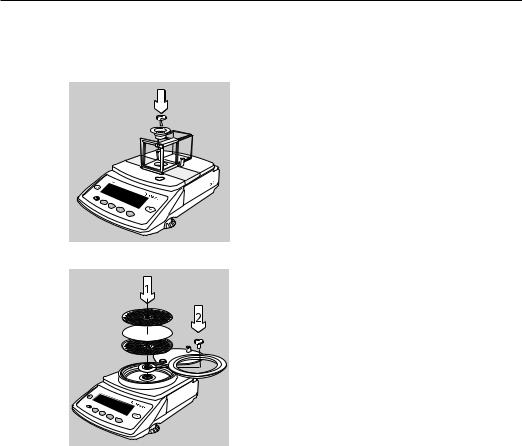
Setting up the
Balance/Scale
Model CP2P
§Remove the adhesive tape from the chamber doors
§Place the components listed below
inside the chamber in the order given:
–Interior draft shield
–Weighing pan
Model CP2P-F
1) Weighing filters of up to 125 mm d:
§Lift the chamber lid gently and turn it to the left or right
§Place the components listed below inside the chamber in the order given:
–Interior draft shield
–Filter pan
–Cover the sample (filter) with the lid or
2) Weighing with the standard weighing pan
(20 mm d):
§Lift the chamber lid gently and turn it to the left or right
§Place the components listed below inside the
chamber in the order given:
–Interior draft shield
–Spacer ring
–Weighing pan
7
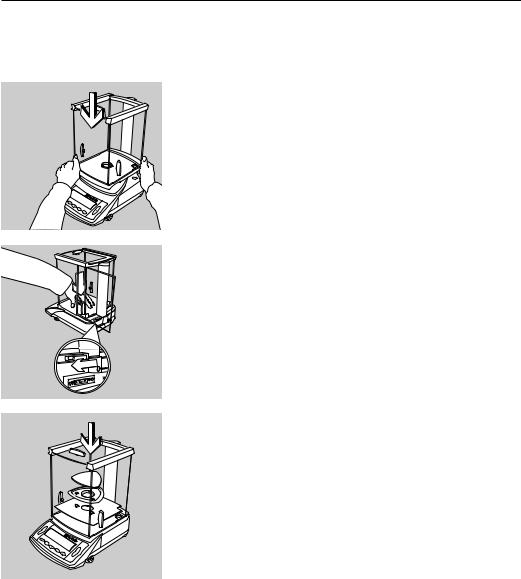
Balances/Scales with an Analytical Draft Shield Chamber:
!Move the sliding lock on the back of the draft shield to the right (open position)
§Position the draft shield carefully on the balance/scale
§Secure the draft shield in position by moving the sliding lock device on the back of the balance/scale to the left while pressing down gently on the floor of the draft shield
§Place the components listed below inside the chamber in the order given:
–Base plate
–Shield disk (not available for CP…-DS models)
–Weighing pan
–Gem tray (GC models only)
8
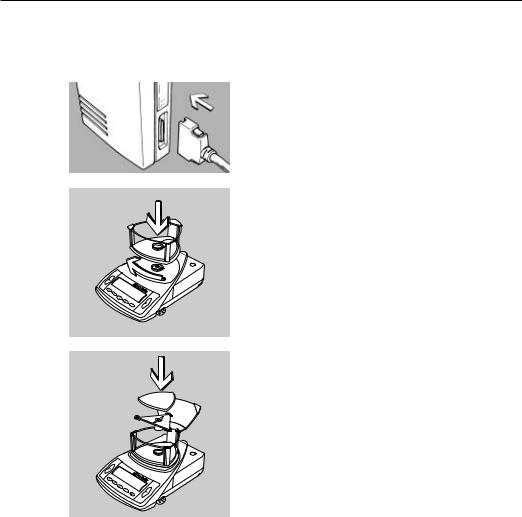
Connecting the Electronics Box to
Model CP225D (-0CE)
–Insert the connector on the cable in to the socket on the electronics box
Balances/Scales with a 3-sided
Draft Shield:
§Place the draft shield on the balance/scale with the cover opening in front on the right
§Turn the draft shield clockwise until it is firmly in position
§Place the components listed below inside the chamber in the order given:
–Base plate
–Pan support
–Weighing pan
$Accessing the weighing chamber from the side: Pull out the side panels one at a time
9
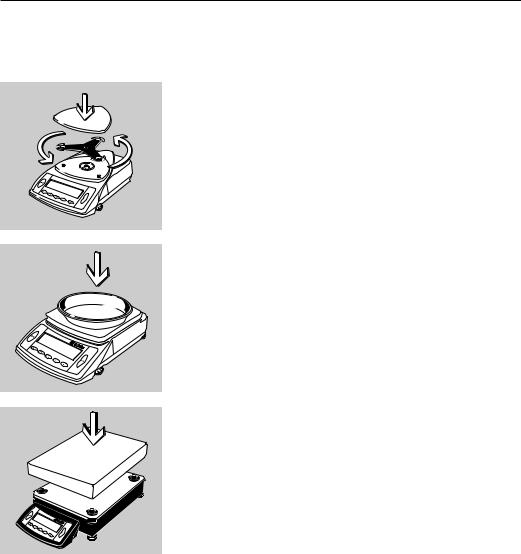
CP622
§Place the components listed below on the balance/scale in the order given:
–Pan support
–Weighing pan
Balances/Scales with a Rectangular Weighing Pan and a Weighing Capacity of up to 10 kg
§Place the components listed below on the balance/scale in the order given:
–Weighing pan
–Gem tray (GP scales only)
Balances/Scales with a Rectangular Weighing Pan and a Weighing Capacity over 10 kg
§Place the weighing pan on the balance/scale
Connecting the Balance/Scale to
AC Power/Safety Precautions
$Use only original Sartorius AC adapters. The protection rating on the AC adapter is IP20 in accordance with EN60529.
$See “Accessories" for information on using an IP65-protected industrial AC adapter or an external rechargeable battery pack with your balance/scale.
10

CP225D:
●Insert the right-angle plug into the jack on the electronics box
All Other Balances/Scales with
a Weighing Capacity of up to 10 kg:
●Insert the right-angle plug into the jack on the balance/scale
Connect the power cable to the AC adapter (on balances/scales with weighing capacities of up to 10 kg)
$Use an original Sartorius AC adapter with
a wide input voltage range (100 ... 240 V~), order number 6971966, and replaceable power cable:
6900900 (Europe)
6900901 (US/CDN)
6971945 (UK)
6900905 (AUS)
6900902 (ZA)
Balances/Scales with a Weighing Capacity
of over 10 kg:
●Insert the right-angle plug into the jack and tighten the screw.
11

Safety Precautions
Balance/scale-specific AC adapter: The AC adapter rated to Class 2 can be
plugged into any wall outlet without any additional safety precautions.
Model 6971966 universal AC adapter: The AC adapter rated to Class 1 can be
plugged into any wall outlet using a protective bonding conductor (= grounding) without any additional safety precautions. The ground or earth terminal is connected to the balance/scale housing, which can be additionally grounded, if required. The data interface is also electrically connected to the balance/scale housing (ground).
Note:
This equipment has been tested and found to comply with the limits pursuant to part 15 of FCC Rules. These limits are designed to provide reasonable protection against harmful interference. This equipment generates, uses and can radiate radio frequency energy and, if not installed and used in accordance with these instructions, may cause harmful interference to radio communications.
For information on the specific limits and class of this equipment, please refer to the Declaration of Conformity. Depending on the particular class, you are either required or requested to correct the interference.
If you have a Class A digital device, you need to comply with the FCC statement as follows: “Operation of this equipment in a residential area is likely to cause harmful interference in which case the user will be required to correct the interference at his own expense.”
If you have a Class B digital device, please read and follow the FCC information given below:
However, there is no guarantee that interference wil not occur in a particular installation. If this equipment does cause harmful interference to radio or television reception, which can be determined by turning the equipment off and on, the user is encouraged to try to correct
the interference by one or more of the following measures:
–Reorient or relocate the receiving antenna.
–Increase the separation between the equipment and receiver.
–Connect the equipment into an outlet on a circuit different from that to which the receiver is connected.
–Consult the dealer or an experienced radio/TV technician for help.
Before you operate this equipment, check which FCC class (Class A or Class B) it has according to the Declaration of Conformity included. Be sure to observe the information of this Declaration.
12

Connecting Electronic Peripheral Devices
§Make absolutely sure to unplug the balance/ scale from AC power before you connect or disconnect a peripheral device (printer or PC) to or from the interface port.
Warmup Time
To deliver exact results, the balance/scale must warm up as listed below after initial connection to AC power or after a relatively long power outage.
–Model CP2P microbalance: at least 4 hours
–All other precision and analytical models: at least 30 minutes
Only after this time will the balance/scale have reached the required operating temperature.
Using Verified Balances/Scales as Legal
Measuring Instruments in the EU*
$The balance/scale must warm up for at least 24 hours after initial connection to AC power.
Leveling the Balance/Scale
Purpose
–To compensate for unevenness at the place of installation.
–To achieve perfectly horizontal positioning of the balance/scale for consistent reproducibility
Always level the balance/scale again after any time it has been moved.
*including the Signatories of the Agreement on the European Economic Area
13

Leveling Balances/Scales with a Weighing Capacity of up to 10 kg
Only the 2 front feet are used for leveling.
§Retract the 2 rear feet (on models with rectangular weighing pans only).
§Turn the 2 front feet as shown in the diagram until the air bubble is centered within the circle of the level indicator.
>In most cases this will require several adjustment steps
§For weighing heavy samples:
Extend the 2 rear feet until they touch the surface on which the balance/scale rests (on models with rectangular weighing pans only).
Leveling Balances/Scales with a Weighing Capacity over 10 kg
§Adjust the leveling feet until the air bubble is centered within the circle of the
level indicator
Antitheft Locking Device on Balances/ Scales with a Weighing Capacity of up to 10 kg
To fasten an antitheft locking device,
use the lug located on the rear panel of the balance/scale.
●Secure the balance/scale at the place of installation, e.g., with a chain or a lock.
14

Operation
Overview of Display and Operating Elements |
|
|
|
|
15 |
|
|
|
1 |
2 |
|
|
|
2 |
14 |
|
|
|
3 |
13 |
|
|
|
4 |
12 |
|
|
P/ |
5 |
11 |
|
|
6 |
|
|
|
|
||
10 |
|
|
|
7 |
9 |
|
|
|
8 |
Designation |
Description |
Designation |
Description |
|
1 |
Weight units |
10 |
Delete (Clear Function) |
2 |
Tare function: |
|
This key is generally used to |
|
Press here to tare the weight |
|
interrupt/cancel functions; |
|
of any container so that the |
|
for example: |
|
readout shows the net weight |
|
– to end an application |
|
of samples. |
|
program |
3 |
Symbol indicating that a GLP- |
|
– to interrupt calibration/ |
|
compliant printout is being |
|
adjustment routines |
|
generated |
11 |
On/Off key: |
4 |
Symbol indicating that a |
|
Switches the display on/off. |
|
printout is being generated |
|
(The balance/scale may remain |
5 |
Symbol indicating data in |
|
in standby mode, depending |
|
memory, when using the |
|
on the settings.) |
|
net-total formulation program |
12 |
Symbol indicating that the cal- |
6 |
Data output function |
|
ibration/adjustment |
|
(p/r) |
|
function is active |
|
Press this key to send |
13 |
Symbol indicating that the |
|
displayed values over the |
|
animal weighing program |
|
built-in data interface to a |
|
is active, with |
|
DataPrint printer or a PC. |
|
automatic-start function |
7 |
Function key: |
14 |
Symbol indicating stand-by |
|
Starts an application program |
|
mode or zero range |
8 |
Symbol indicating the active |
15 |
Weight readout in the selected |
|
program |
|
weight unit |
9Press here to start calibration/ adjustment
15

Basic Weighing Function
Purpose
The basic weighing function is always accessible and can be used alone or in combination with an application program (counting, weighing in percent, etc.).
Features
–Taring the balance/scale
You can tare the balance/scale within the entire weighing range.
–Assigning IDs to weights (as needed)
–Printing weights
Using Verified Balances/Scales as Legal Measuring Instruments in the EU*:
The type-approval certificate for verification applies only to non-automatic weighing instruments; for operation with or without auxiliary measuring devices, you must comply with the regulations of your country applicable to the place of installation of your balance/scale.
●Before using the balance/scale as a legal measuring instrument, calibrate and adjust it at the place of use using the built-in motorized calibration and adjustment weight (span adjustment device): see the “Calibration/
Adjustment" section in this chapter
$The temperature range (°C) indicated on the verification label may not be exceeded during operation
Example: BD BL 200
K +10 … +30°C
*including the Signatories of the Agreement on the European Economic Area
Working with CP2P… Models:
Working with the microbalance requires
a steady hand and a smooth, uninterrupted technique.
Use forceps or other suitable utensil to place the sample on the weighing pan.
Perform a number of test measurements before you begin weighing, to allow the temperature inside the weighing chamber to adjust to the ambient temperature outside the chamber. Otherwise, if the chamber door was closed for a long period of time prior to beginning weighing, the sudden change in temperature inside the chamber when you open the door might affect the weight readout. This is why we recommend starting with a series of test measurements; the repeated opening and closing of the weighing chamber door, at the same rate as you will be doing during the actual weighing sequence, will both compensate this difference in temperature to some extent and help you develop a smooth working rhythm.
Place the sample gently on the weighing pan. The weight readout should stabilize within 15 to 20 seconds.
The degree of precision attained increases in proportion as each weighing operation in a sequence of measurements becomes more identical.
16
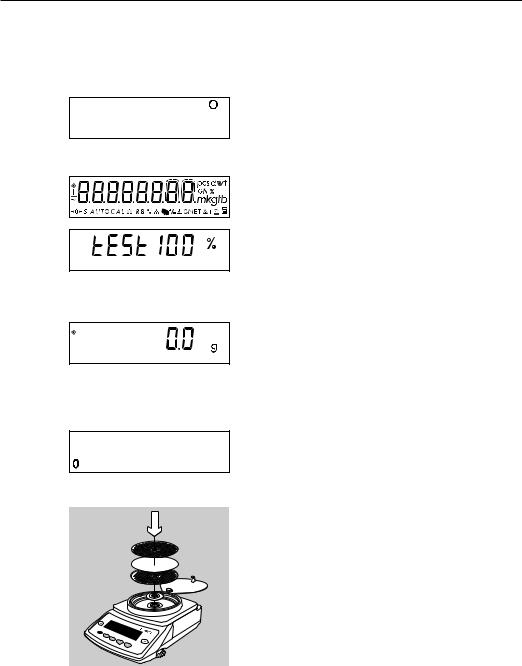
Preparation
A circle displayed in the upper right-hand corner indicates that the balance/scale has been disconnected from power (the power cable was unplugged or due to power failure).
● Turn on the balance/scale: Press e
>All symbols on the display light up briefly.
>The balance/scale performs a display test. ● To change configurations: see the chapter
entitled “Configuration"
●To load factory-set default configurations: see “Configuration" (menu code 9 - -1)
$To tare the balance/scale: Press t When the balance/scale is switched on, the b is displayed until you press a key. If the b symbol is displayed during operation, this indicates that the processor
is performing a function and cannot receive further commands at the moment.
Additional Functions
●Turning off the balance/scale: Press e A zero in the lower left-hand corner indicates that the balance/scale has been switched off and is in stand-by mode.
Filter Weighing with Model CP2P-F
The CP2P-F filter microbalance comes with a filter pan that has a utilizable diameter of 125 mm as standard equipment. Place the filter on the pan and close the lid.
17

Analytical and Precision Balances:
 2
2 
1 
Microbalance CP2P..:
Below-Balance/Under-Scale Weighing
A port for a below-balance/under-scale weighing hanger is located on the bottom of the balance/scale. You can order the hanger directly from Sartorius for balances/scales with a weighing capacity over 12 kg
(see “Accessories").
●Open cover plate on the bottom of the balance/scale.
●Using the built-in hanger (1): Attach the sample (e.g., using a suspension wire) to the hanger
$Bore hole (2): Carefully fasten the special hanger, or order a hanger directly from Sartorius.
$If necessary, install a shield for protection against drafts
Important Note Concerning Verified Balances/Scales Approved for Use as Legal Measuring Instruments in the EU*:
The below-balance/under-scale weighing port may not be opened or used when an approved balance/scale is being operated as a legal measuring instrument.
●Remove the brass screw
●Suspend the below-balance weighing hook supplied from the hanger
●If necessary, install a shield for protection against drafts
*including the Signatories of the Agreement on the European Economic Area
18
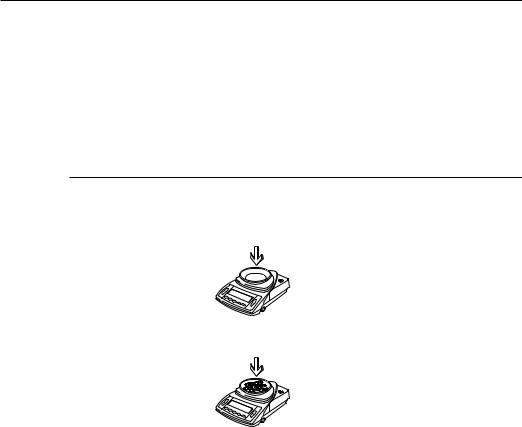
Example
Simple Weighing
Setting in Balance/Scale Operating Menu: Line format for printout: For other applications/GLP (7 2 2)
Step |
Key (or instruction) |
Display/Printout |
||
1. |
Turn on the balance/scale |
e |
+ |
0.0 g |
|
Self-test is performed, |
|
|
|
|
followed by automatic initial |
|
|
|
|
tare function. |
|
|
|
2. |
Place container on balance/scale |
|
+ |
11.5 g |
|
(in this example: 11.5 g). |
|
|
|
3. |
Tare the balance/scale. |
t |
+ |
0.0 g |
4. |
Place sample in container |
|
+ |
132.0 g |
|
on balance/scale |
|
|
|
|
(in this example: 132 g). |
|
|
|
6. Print weight. |
p/r |
N |
+ |
132.0 g |
19

Calibration/Adjustment
Purpose
Calibration is the determination of the difference between the weight readout and the true weight (mass) of a sample. Calibration does not entail making any changes within the balance/scale.
Adjustment is the correction of any difference between the measured value displayed and the true weight (mass) of the sample, or the reduction of the difference to an allowable level within the maximum permissible error limits.
Using Verified Balances/Scales as Legal Measuring Instruments in the EU*:
Before using your balance/scale as a legal measuring instrument, you must perform “internal calibration" at the place of installation after the warmup period.
Features
Calibration/adjustment can be performed only when
–there is no load on the balance/scale,
–the balance/scale is tared,
–the internal signal is stable.
If these conditions are not met, an error message is displayed (Err 02).
Adjustment can be performed
–automatically following calibration (menu code 1 10 1) or
–manually, at operator discretion, after calibration (1 10 2)
*including the Signatories of the Agreement on the European Economic Area
The weight displayed for the sample on the balance/scale must not differ from the nominal weight by more than 2%.
You can use any of the following weight units to calibrate/adjust: g, kg, lb (1 11 1 to 3)
You can block calibration/adjustment of the balance/scale:
–Select menu code 1 9 7, and
–Close the menu access switch on the back of the balance/scale
You can have the calibration/adjustment results documented in a ISO/GLP-compliant printout (see page 53).
For service technicians only:
External Calibration in Verified Balances/ Scales of Accuracy Class K
–External calibration can be made accessible only after removing the verification control seal.
>In this case, the validity of the verification becomes void and the balance/scale must be re-verified.
20

Calibration/Adjustment Sequence
You can configure the operating menu so that:
–adjustment automatically follows calibration in a single operation (1 10 1), or
–the operator chooses whether to end the calibration/adjustment routine or have adjustment performed (1 10 2)
If there is no deviation, or if the difference is within the effective requirements for accuracy of measurements,
it is not necessary to adjust the balance/ scale. In this case, you can end the calibration routine following calibration. Two keys are active at that point:
–q= start adjustment
–c= end the calibration/
adjustment routine
Factory Settings
Calibration adjustment mode for models without built-in motorized calibration weight:
External calibration (1 9 1)
Calibration adjustment mode for models with built-in motorized calibration weight: Internal calibration (1 9 3)
Calibration/adjustment sequence: Adjustment automatically follows calibration in a single operation (1 10 1)
Weight unit for calibration: grams (1 11 1)
ISO/GLP-compliant printout: off (8 10 1)
21

Internal Calibration (for models with built-in calibration weight only)
The built-in calibration weight is standard equipment on all verified balances/scales and on the following standard (non-verified) models:
CP2P.., CP225D, CP324S, CP224S, CP64, GC1603P, GC803S, GC803P
Settings:
Calibration/adjustment mode: Internal calibration/adjustment (menu code 1 9 3)
There is a motorized calibration weight within the balance/scale housing which is applied and removed automatically for internal calibration.
Step |
Key (or instruction) |
Display/Printout |
|||
1. |
Turn on balance/scale, |
e |
|
0.0 g |
|
|
if necessary. |
|
|
|
|
2. |
Tare the balance/scale, |
t |
|
0.0 g |
|
|
if necessary. |
|
|
|
|
3. |
Start calibration/adjustment |
q |
CAL |
c |
|
|
Internal weight is applied |
|
|
|
|
|
automatically. |
|
|
|
|
4. |
Balance/scale is calibrated |
|
– |
0.2 g |
G |
|
(displayed only if menu |
|
CAL |
± |
|
|
code 1 10 2 is set). |
|
|
|
|
5. |
If the menu code for |
|
Adjust* |
|
|
|
“calibration and adjustment |
|
CAL |
|
|
|
in a single step" (1 10 1) |
|
|
|
|
|
is set, the balance/scale is |
|
|
|
|
|
adjusted automatically now. |
|
|
|
|
6. |
At this point, adjustment |
|
CAL |
CC |
|
|
is completed. |
|
|
|
|
7. |
Internal weight is unloaded. |
|
|
0.0 g |
|
* displayed only if menu item 1 10 2 is selected.
22

External Calibration
Settings:
Calibration/adjustment mode: External calibration/adjustment (menu code 1 9 1)
The weight required for calibration/adjustment is defined in the factory settings (see “Specifications").
Step |
Key (or instruction) |
Display/Printout |
|||
1. |
Turn on the balance/scale, |
e |
|
0.0 g |
|
|
if necessary. |
|
|
|
|
2. |
Tare the balance/scale, |
t |
|
0.0 g |
|
|
if necessary. |
|
|
|
|
3. |
Start calibration/adjustment. |
q |
+5000.0 g |
G |
|
|
|
|
CAL |
|
|
4. |
Apply the prompted calibration |
|
|
|
|
|
weight (in this example: |
|
|
|
|
|
5000 g). |
|
|
|
|
5. |
Balance/scale is calibrated |
|
– |
0.2 g |
G |
|
(displayed only if menu |
|
CAL |
± |
|
|
code 1 10 2 is set). |
|
|
|
|
6. |
If the menu code for |
|
Adjust* |
|
|
|
“calibration and adjustment |
|
CAL |
|
|
|
in a single step" (1 10 1) |
|
|
|
|
|
is set, the balance/scale is |
|
|
|
|
|
now adjusted automatically. |
|
|
|
|
7. |
At this point, adjustment |
|
CAL |
CC |
|
|
is completed. |
|
|
|
|
8. |
After calibration, the weight |
|
+ 5000.0 g |
|
|
|
unit is shown. |
|
|
|
|
9. |
Remove the calibration weight. |
|
|
0.0 g |
|
* |
displayed only if menu item 1 10 2 is selected. |
|
|
|
|
23

Configuration
Purpose
You can configure your balance/scale to meet individual requirements by selecting from parameter settings in a software menu.
Key functions during configuration:
Activate the settings menu:
Press eto turn the balance/scale off and back on again. While all display segments are lit, press tbriefly
Scroll upward ↑ : press q Scroll right → : press p/r Confirm input: press t Store settings and exit menu: Press and hold t(2 sec.)
● Print Current Settings
–At the 3rd menu level (lowest level): Press and hold p/r
> Printout: (Example)
Menu 7 1 1
–At the 2nd menu level: Press and hold p/r
> Printout (Example)
Menu 7 1 1
Menu 7 2 1
Menu 7 3 1
–All current menu settings are printed
when the 1st menu level (highest level) is displayed: Press and hold p/r
> All current settings are printed.
24
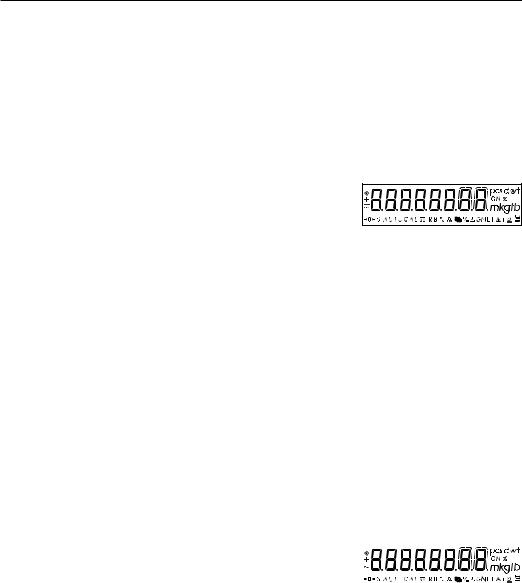
Setting the Parameters (Menu Codes)
Example: Adapting the balance/scale to “very unstable" ambient conditions (menu code 1 1 4).
Step |
Key (or instruction) |
Display/Printout |
1. Turn off the balance/scale. |
e |
|
2. |
Turn on the balance/scale and |
e |
|
|
|
while all segments |
|
1 |
|
|
are displayed: |
tbriefly |
|
|
$ Scroll upward within a |
q |
2 |
|
|
|
menu level; after the last |
repeatedly |
... |
|
|
menu code, the first |
|
9 |
|
|
code is displayed again. |
|
1 |
|
3. |
Select the second level |
p/r |
1 |
1 |
|
(scroll to the right). |
|
|
|
4. |
Select the third level |
p/r |
1 1 2 o |
|
|
(scroll to the right). |
|
|
|
5. |
3rd menu level: |
q |
1 1 4 |
|
|
Scroll until the desired |
repeatedly |
||
|
number is shown. |
|
|
|
6. |
Confirm change; “o" |
t |
1 1 4 o |
|
|
on display indicates |
|
|
|
|
active setting |
|
|
|
$ Return to higher menu level |
p/r |
1 |
||
|
(from the 3rd level). |
|
|
|
$ Set other codes as desired. |
p/r, q |
|
|
|
7. |
Store settings and exit |
Press and |
|
|
|
the menu |
hold t(2 sec.) |
|
|
|
|
|
||
|
or |
|
|
|
|
|
|
|
|
$ Exit menu without storing |
|
|
|
|
|
|
|
||
|
changes. |
e |
|
|
> |
Restart application. |
|
|
0.0 g |
25

Parameter Settings (Overview) o Factory settings
√ User-defined setting
|
|
|
|
1 |
|
|
|
|
2 |
|
|
|
|
|
|
|
|
|
|
3 |
|
setting |
|
|
|
|
|
|
M |
level |
|
M |
level |
M |
|
level |
Factory |
|
M |
item |
|||||||||||
|
|
|
|
|
|
|
|
|
|
|
|
|
|
|
|
|
|
|
|||||||
|
|
|
enu |
|
|
|
|
enu |
|
|
|
|
|
|
|
|
enu |
|
|
|
|
|
enu |
|
|
Menu |
|
|
1 Weighing |
|
|
1 1 |
Adapt filter |
|
|
|
|
|
1 1 |
1 |
|
|
Very stable conditions |
||||||||
|
|
|
|
|
|
|
|
|
(ambient conditions) |
|
1 1 |
2 |
|
o |
Stable conditions |
||||||||||
|
|
|
|
|
|
|
|
|
|
|
|||||||||||||||
|
|
|
|
|
|
|
|
|
|
|
|
|
|
|
|
1 |
1 |
3 |
|
|
Unstable conditions |
||||
|
|
|
|
|
|
|
|
|
|
|
|
|
|
|
|
|
|
||||||||
|
|
|
|
|
|
|
|
|
|
|
|
|
|
|
|
1 |
1 |
4 |
|
|
Very unstable conditions |
||||
|
|
|
|
|
|
|
|
|
|
|
|
|
|
|
|
|
|
||||||||
|
|
|
|
|
|
|
|
1 2 |
Application filter |
|
|
1 2 |
1 |
|
o |
Final readout |
|
||||||||
|
|
|
|
|
|
|
|
|
|
|
|
|
|
|
|
1 |
2 |
2 |
|
|
Filling mode |
|
|||
|
|
|
|
|
|
|
|
|
|
|
|
|
|
|
|
|
|
|
|||||||
|
|
|
|
|
|
|
|
1 3 |
Stability range |
|
|
1 3 |
1 |
|
|
4 digit |
|
|
|||||||
|
|
|
|
|
|
|
|
|
The stability symbol is |
|
1 3 |
2 |
|
|
1 digit |
|
|
||||||||
|
|
|
|
|
|
|
|
|
|
|
|
|
|
||||||||||||
|
|
|
|
|
|
|
|
|
displayed when the |
|
1 3 |
3 |
|
|
1 digit |
|
|
||||||||
|
|
|
|
|
|
|
|
|
|
|
|
|
|
||||||||||||
|
|
|
|
|
|
|
|
|
value is stable within |
|
1 3 |
4 |
|
o |
2 digits |
|
|
||||||||
|
|
|
|
|
|
|
|
|
|
|
|
|
|||||||||||||
|
|
|
|
|
|
|
|
|
this number of digits. |
|
1 3 |
5 |
|
|
4 digits |
|
|
||||||||
|
|
|
|
|
|
|
|
|
|
|
|
|
|
||||||||||||
|
|
|
|
|
|
|
|
|
|
|
|
|
|
|
|
1 |
3 |
6 |
|
|
8 digits* |
|
|
||
|
|
|
|
|
|
|
|
|
|
|
|
|
|
|
|
|
|
|
|
||||||
|
|
|
|
|
|
|
|
1 5 |
Tare function* |
|
|
|
1 5 |
1 |
|
|
Without stability |
||||||||
|
|
|
|
|
|
|
|
|
|
|
|
|
|
|
|
1 |
5 |
2 |
|
o |
After stability |
|
|||
|
|
|
|
|
|
|
|
|
|
|
|
|
|
|
|
|
|
||||||||
|
|
|
|
|
|
|
|
1 6 |
Auto zero |
|
|
|
|
1 6 |
1 |
|
o |
On |
|
|
|
||||
|
|
|
|
|
|
|
|
|
|
|
|
|
|
|
|
1 |
6 |
2 |
|
|
Off |
|
|
|
|
|
|
|
|
|
|
|
|
|
|
|
|
|
|
|
|
|
|
|
|
|
|||||
|
|
|
|
|
|
|
|
1 7 |
Weight unit 1 |
|
|
|
1 7 |
1 |
|
|
Grams (Display: o)* |
||||||||
|
|
|
|
|
|
|
|
|
|
|
|
|
|
|
|
1 |
7 |
2 |
|
o |
Grams (Display: g) |
||||
|
|
|
|
|
|
|
|
|
|
|
|
|
|
|
|
|
|||||||||
|
|
|
|
|
|
|
|
|
|
|
|
|
|
|
|
1 |
7 |
3 |
|
|
Kilograms 1) |
|
|||
|
|
|
|
|
|
|
|
|
|
|
|
|
|
|
|
|
|
|
|||||||
|
|
|
|
|
|
|
|
|
|
|
|
|
|
|
|
1 |
7 |
4 |
|
|
Carats |
|
|
||
|
|
|
|
|
|
|
|
|
|
|
|
|
|
|
|
|
|
|
|
||||||
|
|
|
|
|
|
|
|
|
|
|
|
|
|
|
|
1 |
7 |
5 |
|
|
Pounds* |
|
|
||
|
|
|
|
|
|
|
|
|
|
|
|
|
|
|
|
|
|
|
|
||||||
|
|
|
|
|
|
|
|
|
|
|
|
|
|
|
|
1 |
7 |
6 |
|
|
Ounces* |
|
|
||
|
|
|
|
|
|
|
|
|
|
|
|
|
|
|
|
|
|
|
|
||||||
|
|
|
|
|
|
|
|
|
|
|
|
|
|
|
|
1 |
7 |
7 |
|
|
Troy ounces* |
|
|||
|
|
|
|
|
|
|
|
|
|
|
|
|
|
|
|
|
|
|
|||||||
|
|
|
|
|
|
|
|
|
|
|
|
|
|
|
|
1 |
7 |
8 |
|
|
Hong Kong taels* |
||||
|
|
|
|
|
|
|
|
|
|
|
|
|
|
|
|
|
|
||||||||
|
|
|
|
|
|
|
|
|
|
|
|
|
|
|
|
1 |
7 |
9 |
|
|
Singapore taels* |
||||
|
|
|
|
|
|
|
|
|
|
|
|
|
|
|
|
|
|
||||||||
|
|
|
|
|
|
|
|
|
|
|
|
|
|
|
|
1 |
7 |
10 |
|
|
Taiwanese taels* |
||||
|
|
|
|
|
|
|
|
|
|
|
|
|
|
|
|
|
|
||||||||
|
|
|
|
|
|
|
|
|
|
|
|
|
|
|
|
1 |
7 |
11 |
|
|
Grains* |
|
|
||
|
|
|
|
|
|
|
|
|
|
|
|
|
|
|
|
|
|
|
|
||||||
|
|
|
|
|
|
|
|
|
|
|
|
|
|
|
|
1 |
7 |
12 |
|
|
Pennyweights* |
|
|||
|
|
|
|
|
|
|
|
|
|
|
|
|
|
|
|
|
|
|
|||||||
|
|
|
|
|
|
|
|
|
|
|
|
|
|
|
|
1 |
7 |
13 |
|
|
Milligrams 2) |
|
|||
|
|
|
|
|
|
|
|
|
|
|
|
|
|
|
|
|
|
|
|||||||
|
|
|
|
|
|
|
|
|
|
|
|
|
|
|
|
1 |
7 |
14 |
|
|
Parts per pound* |
||||
|
|
|
|
|
|
|
|
|
|
|
|
|
|
|
|
|
|
||||||||
|
|
|
|
|
|
|
|
|
|
|
|
|
|
|
|
1 |
7 |
15 |
|
|
Chinese taels* |
|
|||
|
|
|
|
|
|
|
|
|
|
|
|
|
|
|
|
|
|
|
|||||||
|
|
|
|
|
|
|
|
|
|
|
|
|
|
|
|
1 |
7 |
16 |
|
|
Mommes* |
|
|
||
|
|
|
|
|
|
|
|
|
|
|
|
|
|
|
|
|
|
|
|
||||||
|
|
|
|
|
|
|
|
|
|
|
|
|
|
|
|
1 |
7 |
17 |
|
|
Austrian carats* |
|
|||
|
|
|
|
|
|
|
|
|
|
|
|
|
|
|
|
|
|
|
|||||||
|
|
|
|
|
|
|
|
|
|
|
|
|
|
|
|
1 |
7 |
18 |
|
|
Tola* |
|
|
||
|
|
|
|
|
|
|
|
|
|
|
|
|
|
|
|
|
|
|
|
||||||
|
|
|
|
|
|
|
|
|
|
|
|
|
|
|
|
1 |
7 |
19 |
|
|
Baht* |
|
|
||
|
|
|
|
|
|
|
|
|
|
|
|
|
|
|
|
|
|
|
|
||||||
|
|
|
|
|
|
|
|
1 8 |
|
|
|
|
|
|
|
1 |
7 |
20 |
|
|
Mesghal* |
|
|
||
|
|
|
|
|
|
|
|
see next page |
|
|
|
|
|||||||||||||
|
|
|
|
|
|
|
|
|
|
|
|
|
|
|
|
|
|
||||||||
|
|
|
|
|
|
|
|
|
|
|
|
|
|
|
|
|
|
||||||||
|
|
|
2 through 9 |
|
|
see next pages |
|
|
|
|
|
|
|
|
|
|
|||||||||
|
|
|
|
|
|
|
|
|
|
|
|
|
|
|
|||||||||||
* = Setting cannot be changed on verified balances/scales |
|
|
|
|
|
|
|
|
|
|
|||||||||||||||
1) = Not available in the CP64-0CE
2) = Not available in verified balances/scales of accuracy class K
26

|
|
|
|
|
1 |
|
|
|
|
|
2 |
|
|
|
|
|
|
|
|
|
|
|
enu |
level |
|
|
enu |
level |
|||||||||
|
|
|
|
|
|
|
|
|
|
|
|
|
|
|
|
|
||
|
|
|
M |
|
|
|
|
M |
|
|
|
|
|
|
|
|
||
Menu |
|
|
1 |
Weighing |
|
|
|
1 1 |
through 1 7 |
|
|
|
|
|
|
|||
|
|
|
|
|
|
|
|
|
1 |
8 |
Display accuracy 1* |
|
|
|||||
|
|
|
|
|
|
|
|
|
1 |
9 |
qkey function |
|
|
|||||
|
|
|
|
|
|
|
|
|
|
|
||||||||
|
|
|
|
|
|
|
|
|
1 |
10 |
Calibration/ |
|
|
|
|
|
||
|
|
|
|
|
|
|
|
|
|
|
|
|
|
|||||
|
|
|
|
|
|
|
|
|
|
|
||||||||
|
|
|
|
|
|
|
|
|
|
|
adjustment sequence |
|
||||||
|
|
|
|
|
|
|
|
|
1 |
11 |
Weight unit for |
|
|
|
|
|||
|
|
|
|
|
|
|
|
|
|
|
|
|||||||
|
|
|
|
|
|
|
|
|
2 1 |
calibration weight* |
|
|||||||
|
|
|
|
|
|
|
|
|
|
|||||||||
|
|
|
2 |
Application |
|
|
Program selection |
|
|
|
||||||||
|
|
|
|
|
|
|
|
|
||||||||||
|
|
|
|
programs |
|
|
|
|
|
|
|
|
|
|
|
|||
|
|
|
|
|
|
|
|
|
|
|
|
|
|
|
||||
|
|
|
|
|
|
|
|
|
|
|
|
|
|
|
|
|
|
|
|
|
|
|
|
|
|
|
|
|
|
|
|
|
|
|
|
|
|
|
|
|
|
|
|
|
|
|
|
|
|
|
|
|
|
|
|
|
|
|
|
|
|
|
|
|
|
|
|
|
|
|
|
|
|
|
|
3 through 9 |
|
see following pages |
|
* = Setting cannot be changed on verified balances/scales 1) = Not available in balances/scales of accuracy class K
2) = On models with built-in motorized calibration weight only 3) = Not available in CP…-ACE/…-PCE models
|
|
|
3 |
|
setting |
|
|
|
M |
|
level |
Factory |
|
M |
item |
||
|
|
|
|
|||||
|
enu |
|
|
|
|
enu |
|
|
see previous page |
|
|
|
|||||
1 |
8 |
1 |
o |
All digits |
|
|
||
1 |
8 |
5 |
|
Reduced by 1 digit* |
||||
1 |
9 |
1 |
o |
External cal./adj. 1) |
||||
1 |
9 |
3 |
|
Internal cal./adj. 2) |
||||
1 |
9 |
7 |
|
qkey blocked |
||||
1 |
10 1 |
o Calibrate, then auto adjust |
||||||
1 |
10 2 |
|
in one operation |
|||||
|
Calibrate, then manual |
|||||||
|
|
|
|
|
adjust |
|
|
|
1 |
11 1 |
o |
Grams |
|
|
|||
1 |
11 2 |
|
Kilograms |
|
|
|||
1 |
11 3 |
|
Pounds |
|
|
|||
2 |
1 |
1 |
o |
Weighing |
|
|
||
2 |
1 |
2 |
|
Toggle weight units |
||||
2 |
1 |
4 |
|
Counting |
|
|
||
2 |
1 |
5 |
|
Weighing in percent 3) |
||||
2 |
1 |
6 |
|
Net-total (tare memory) |
||||
2 |
1 |
7 |
|
Animal weighing/ |
||||
|
|
|
|
|
Averaging 3) |
|
||
27
